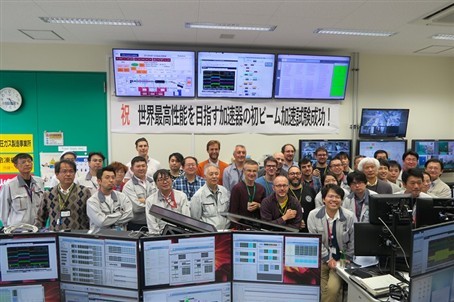Europe and Japan operate accelerator to deliver first beam


The Broader Approach Agreement, signed between Europe and Japan, offers a framework for three R&D projects in the field of fusion energy to push forward the state of play. The International Fusion Materials Irradiation Facility (IFMIF)/ Engineering Validation and Engineering Design Activities (EVEDA) is one of them. With the help of LIPAc, a prototype accelerator, scientists will validate the design of a neutron source which will be used to irradiate materials and key equipment of DEMO, the fusion machine that will come after ITER. QST (Japan) in collaboration with F4E, coordinating the European contributions of INFN (Italy), CIEMAT (Spain), CEA Saclay (France) and SCK-CEN (Belgium), have resulted in this experimental facility with the world’s longest Radio Frequency Quadrupole (RFQ) accelerator, measuring 9.8 m, using eight radio frequency lines.
The components of LIPAc (Rokkasho, Japan) have been installed, commissioned, and in operation, as part of the accelerator, for nearly two years. On 13 June, the RFQ delivered the first beam of particles (so far: protons) reaching the energy of 2.5 MeV. The progress is impressive, especially if one bears in mind that the injector provides protons with energy of 50 keV. The transmission values obtained in June are significant. They represent more than 80% of the beam’s full potential transmitted by the RFQ. This is an essential step towards the acceleration of deuterons, atoms consisting of a proton and neutron, demonstrating the capability of the RFQ design to reach the high currents needed for the neutron source.

The total in-kind contribution to the LIPAc facility by all European parties and Japan is in the range of 100 M EUR taking into consideration infrastructure costs. This result represents ten years of close co-ordination between all Parties. Nearly 90% of the European hardware has been delivered and commissioning is halfway through. Roland Heidinger, F4E European Project Manager for IFMIF/EVEDA, explains “this first beam is the dawn of the accelerator operations. We have taken a step forward paving the way for more qualifications during 2019.” Philippe Cara, IFMIF/EVEDA Project Leader, elaborates on the systematic efforts that have been made since 2015 to adapt the schedule to the project plan. “During the last three years we have been working closely with all Parties to develop a realistic schedule and we managed to respect it. We have established a method of international collaboration which works well between Europe and Japan. And on top of that, we have successfully manufactured an entire system in Europe, and installed it in Japan, ensuring full compliance with the standards.”